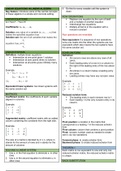Samenvatting
Samenvatting Biostatistics and linear algebra
- Instelling
- Technische Universiteit Eindhoven (TUE)
Samenvatting van het vak Biostatistiek en lineaire algebra (2DM80) inclusief voorbeelden van opdrachten. De samenvatting is in het engels en bevat de samengevatte informatie van hoofdstuk 1 tot en met 6 uit het boek van lay en de samengevatte informatie uit het gehele book openintro statistics.
[Meer zien]





